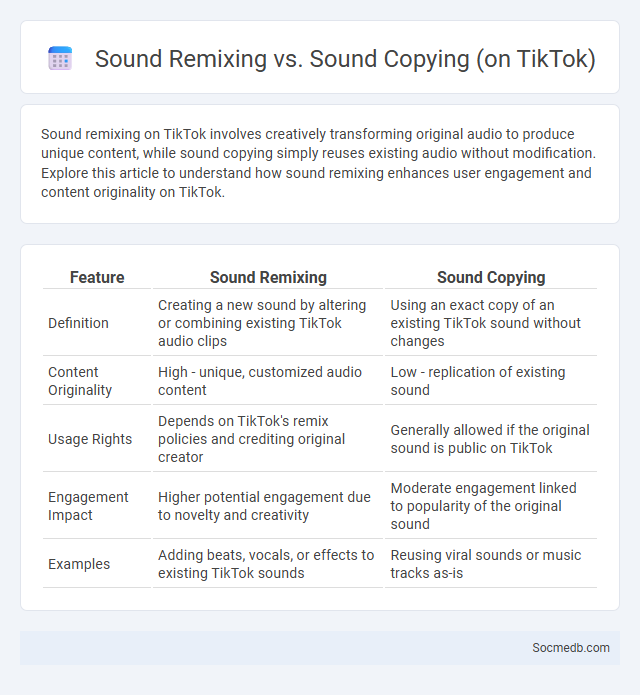
Photo illustration: Sound Remixing vs Sound Copying (on TikTok)
Sound remixing on TikTok involves creatively transforming original audio to produce unique content, while sound copying simply reuses existing audio without modification. Explore this article to understand how sound remixing enhances user engagement and content originality on TikTok.
Table of Comparison
| Feature | Sound Remixing | Sound Copying |
|---|---|---|
| Definition | Creating a new sound by altering or combining existing TikTok audio clips | Using an exact copy of an existing TikTok sound without changes |
| Content Originality | High - unique, customized audio content | Low - replication of existing sound |
| Usage Rights | Depends on TikTok's remix policies and crediting original creator | Generally allowed if the original sound is public on TikTok |
| Engagement Impact | Higher potential engagement due to novelty and creativity | Moderate engagement linked to popularity of the original sound |
| Examples | Adding beats, vocals, or effects to existing TikTok sounds | Reusing viral sounds or music tracks as-is |
Understanding Sound Remixing on TikTok
Sound remixing on TikTok transforms original audio clips into creative variations, allowing you to put a unique spin on popular sounds or trends. This feature leverages TikTok's vast audio library and editing tools to enable seamless integration of remixed sounds into your videos, boosting engagement and reach. Mastering sound remixing helps amplify your content's visibility by tapping into trending audio themes and viral challenges.
Defining Sound Copying in the TikTok Ecosystem
Sound copying in the TikTok ecosystem refers to the replication or reuse of audio clips, music, or sound bites within user-generated videos, often through features like TikTok's Sound Library and Duet functions. This practice enables viral trends and challenges by allowing creators to build on popular sounds, fostering community engagement and content discoverability. Understanding sound copying is essential for navigating copyright issues and maximizing creative collaboration on the platform.
The Basics of Sound Copyright Laws
Understanding sound copyright laws is crucial for anyone using audio on social media platforms like YouTube, Instagram, or TikTok. Copyright protects original sound recordings and compositions, requiring users to obtain licenses or permissions before using music or sound effects. Violating these laws can result in content removal, demonetization, or legal penalties, making it essential to use royalty-free sounds or secure proper rights for audio content.
Key Differences: Remixing vs Copying Sounds
Remixing sounds on social media involves creatively altering and combining existing audio clips to produce new, original content that showcases your unique style and interpretation. Copying sounds, on the other hand, means using an audio clip exactly as it is without modification, which limits your creative expression and may impact engagement negatively. Your ability to remix rather than copy sound significantly enhances content originality, increasing reach and user interaction on platforms like TikTok and Instagram.
Legal Implications of Using Copyrighted Sounds
Using copyrighted sounds on social media can lead to legal consequences such as copyright infringement claims, resulting in content removal, account suspension, or monetary fines. Platforms like Instagram, TikTok, and YouTube implement automated systems like Content ID to detect unauthorized use of copyrighted audio, enforcing rights holders' protections. To avoid legal risks, creators should seek proper licenses, use royalty-free sounds, or utilize platform-provided music libraries with cleared usage rights.
Creative Freedom and Remix Culture on TikTok
TikTok empowers creators by offering unparalleled creative freedom, enabling you to experiment with diverse formats, trends, and audio to produce unique content. The platform's remix culture thrives through features like Duets and Stitches, allowing users to blend, respond, and transform existing videos into new interpretations that amplify engagement. This dynamic ecosystem encourages innovation, fosters community collaboration, and continuously reinvents digital storytelling.
How TikTok Handles Sound Copyright Enforcement
TikTok employs a robust sound copyright enforcement system that utilizes advanced audio recognition technology to detect unauthorized use of copyrighted music and sounds. The platform partners with major record labels and rights holders, enabling automated removal or monetization of infringing content through licensing agreements. Its content ID system continuously scans uploads, ensuring compliance with copyright laws while providing creators with access to licensed sound libraries.
Fair Use and Its Limits for TikTok Creators
Fair Use on TikTok allows creators to use copyrighted material without permission under certain conditions, such as commentary, criticism, or parody. Your content must transform the original work and not compete with the market value to qualify for Fair Use protection. Understanding the specific limits, including the amount and nature of the content used, helps prevent copyright strikes and maintain your account's integrity.
Best Practices for Using and Crediting Sounds on TikTok
Optimizing your TikTok content involves selecting trending sounds and properly crediting original creators to enhance visibility and foster community respect. Use TikTok's built-in features to link sounds, ensuring your audience can explore the source and you comply with copyright guidelines. Respecting creators by giving credit boosts your credibility and helps maintain a positive platform environment for Your content growth.
The Future of Sound Rights and Digital Creativity
Sound rights in social media are rapidly evolving as digital platforms integrate advanced audio recognition and blockchain technology to secure creators' intellectual property. Future frameworks will emphasize transparent royalty distribution, empowering musicians and sound artists to monetize original content more effectively. This shift is driving innovation in digital creativity, fostering new collaborative opportunities and immersive audio experiences for global audiences.
 socmedb.com
socmedb.com